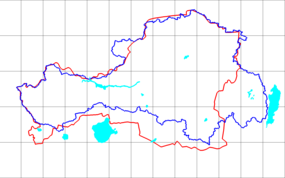
Back Uryanxay diyarı Azerbaijani Urjanchai Krai German Krai de Urianjái Spanish Territorio di Urjanchaj Italian Ұранқай өлкесі Kazakh Kraj Oerjanchaj Dutch Kraj Urianchajski Polish Урянхайский край Russian Урааҥхай сирэ (Уриаҥхай кыраайа) SAH Uryankay Krayı Turkish
Uryankhay Krai | |||||||||||||
|---|---|---|---|---|---|---|---|---|---|---|---|---|---|
| 1914–1921 | |||||||||||||
 Blue line is the Uryankhay Krai's border. Red line is the Tuvan Autonomous Oblast border. | |||||||||||||
| Status | Protectorate of Russia | ||||||||||||
| Capital | Belotsarsk | ||||||||||||
| Common languages | Tuvan Russian Chinese | ||||||||||||
| Demonym(s) | Tuvan | ||||||||||||
| Government | Republic | ||||||||||||
| Amban Noyan | |||||||||||||
• 1914–1915 | Oyun Ölzey-Ochur oglu Kombu-Dorzhu | ||||||||||||
• 1915–1916 | Irgit Agbaan-Demchi | ||||||||||||
• 1916–1921 | Oyun Kombu-Dorzhu oglu Sodunam-Balchyr | ||||||||||||
| Historical era | World War I, Russian Civil War | ||||||||||||
• Established | 17 April 1914 | ||||||||||||
• Became the People's Republic of Tannu Tuva | 14 August 1921 | ||||||||||||
| Population | |||||||||||||
• 1914 | 73,000 | ||||||||||||
| |||||||||||||
| Today part of | Russia | ||||||||||||
Uryankhay Krai[a] was the name of what is today Tuva and was a short-lived protectorate of the Russian Empire that was proclaimed on 17 April 1914, created from the Uryankhay Republic which had recently proclaimed its independence from the Qing dynasty of China in the Mongolian Revolution of 1911.[1][2][3] After the February Revolution and abdication of Tsar Nicholas II, Uryankhay Krai recognized the new Russian Republic and reaffirmed its status as a Russian protectorate in 1917.[1][2]
During the Russian Civil War, the country was occupied by China and Russian "Whites" between 1918 and 1921. Supported by the Red Army, the Tuvan People's Revolutionary Party established the Soviet puppet state of the Tuvan People's Republic (initially Tannu Tuva) on 14 August 1921.[1][2]
Cite error: There are <ref group=lower-alpha> tags or {{efn}} templates on this page, but the references will not show without a {{reflist|group=lower-alpha}} template or {{notelist}} template (see the help page).
- ^ a b c "RossTuva | ТЫВА Tuva". hubert-herald.nl. Retrieved 2018-08-25.
- ^ a b c Cahoon, Ben. "Tannu Tuva". worldstatesmen.org. Retrieved 8 August 2019.
- ^ Урянхайский край // «Историческая энциклопедия Сибири» (2009) [Uryankhayskiy Krai // "Historical Encyclopedia of Siberia" 2009]. irkipedia.ru (in Russian). Archived from the original on 2021-11-07. Retrieved 2021-11-07.
